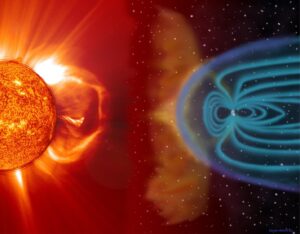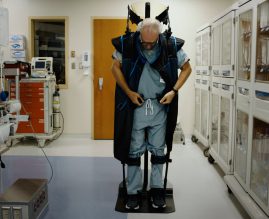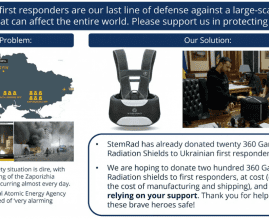Space Radiation Shielding for Getting to Mars
12.20.21 | Monday | Nofit Amir
Rajarshi Pal Chowdhury, PhD
The space radiation environment a crewed spacecraft would have to traverse on its way to Mars is a complex hybrid of solar energetic particles, galactic cosmic rays, and trapped radiation. The radiation threat in deep space is mainly comprised of two components: 1) random bursts of energetic particles (primarily protons) generated by solar activity and 2) the low flux density but highly energetic charged ions that originate from outside the solar system.
Trapped particle radiation is encountered in Earth’s vicinity and is thus a minor contributor for missions beyond the lower-Earth orbit. Beyond the lower-Earth orbit and outside the protection of the Earth’s magnetic field and atmosphere, the space radiation environment is harsh and contains the risk of radiation-borne diseases.
Space Radiation Risks
NASA has classified space radiation effects into four categories: cancer, damage to the central nervous system, degenerative tissue damage, and acute radiation syndrome [1]. Acute effects include nausea, vomiting, skin burn, and for substantial exposure, non-carcinogenic mortality. Long-term effects include deterministic outcomes such as cataract formation, damage to the central nervous system, and cardiovascular disease, as well as stochastic effects, such as cancer [2].
A significant concern with stochastic effects is that there are no known dose thresholds, and thus, it is possible that these effects can occur at relatively low exposure levels. Therefore, the need for space radiation protection is one of the four most significant. The nature of space radiation is unique compared to any other terrestrial radiation, and the data on the effects of this radiation on human bodies are incredibly sparse. To date, only the exposure data for twenty-four astronauts for a 12-day mission outside of the lower-Earth orbit (LEO) environment are available [3]. Because radiation exposure data in deep space are sparse, space radiation risk models rely on exposure data from terrestrial radiation such as Japanese atomic bomb survivor cohort, which may have different biophysical effects than radiation encountered in space. Because space radiation risk assessment is based on mathematical models, and there are significant uncertainties associated with these models. Therefore, to ensure the safety of astronauts in space environments, it is imperative that proper radiation protection measures are in place.

Space Radiation Shielding: Present and Future
Reduced astronaut exposure can be achieved by employing space radiation shielding and lowering exposure time by reducing mission duration or choosing a time when the probability of radiation exposure is low. Space radiation shielding is of two types: 1) active radiation shielding and 2) passive radiation shielding. Active space radiation shielding uses electromagnetic fields to deflect charged particles, constituting about 98% space radiation. In contrast, passive shielding implies blocking space radiation by means of slowing down and fragmenting space radiation components. To date, passive shielding methods are the ones that are used for space radiation shielding by NASA and other eminent organizations worldwide. Passive shielding can be achieved in free-space or during surface stay by shielding spacecraft walls, creating storm shelters within the spacecraft, using wearable radiation shields, and building habitats on the surface of the solar bodies where humans wish to stay. It has been shown in previous studies that hydrogenous materials are the best for shielding space radiation.
There have been many studies to find the right material for shielding that can protect against highly energetic and heavy charged particles and has some structural stabilities. Sometimes, materials such as lunar regolith and Martian soil can be used to build passive shielding for habitats on the surfaces of Moon and Mars. The one issue with the passive shielding is that the mass of materials needed to provide meaningful solutions can be extremely high, and therefore, to launch such heavy structures can cause a significant mass penalty, which is in the range of millions of dollars.
Wearable Space Radiation Shield
Thereby, more innovative methods of radiation shielding need to be incorporated. One such solution is to develop personalized wearable shielding for humans such as AstroRad, which focuses on protecting critical radiosensitive organs, which contribute most towards effective dose and radiation effect induced death (REID) to the human body. This provides optimized protection which achieves the most protection possible per unit mass of shielding material, reducing payload burden while creating opportunity for enhanced ergonomics to the differential thickness geometry of such shielding. This approach may be augmented by inclusion of additive manufacturing facilities in space infrastructure, which can print space radiation protection materials from plastic waste generated in space. The latter method, as pioneered by StemRad and Redwire, combined with the former approach can be a potential solution in the future for humans to avoid the harmful effects of radiation in their way to Mars

Frequently Asked Questions
How are astronauts shielded from radiation?
All astronauts in space are provided some degree of shielding from radiation by the spacecraft hull. Additionally, in low-Earth orbit, such as at the altitude of the International Space Station (ISS), the Earth's magnectic field still provides a strong amount of shielding. Both the spacecraft hull and Earth's magnetic field are effective at stopping low energy radiation, but high intensity and high energy radiation emitted during solar flares or coronal mass ejections can still penetrate these defenses.
How can we protect radiation from space?
For intense solar particle events, crew can enter special radiation "bunkers" in the spacecraft. However, for extended duration events, it can be necessary for some crewmembers to perform various duties in unshielded regions of the spacecraft. Thus, they require personal protective radiation shielding, such as the AstroRad vest, which is specially designed to protect critical organs from space radiation and reduce cancer risk by around 50%.
What type of radiation is in space?
Unlike on Earth, where most radiation is neutrally charged, space radiation primarily consists of positively charged ions spanning the periodic table, with protons and alpha particles comprising 99 percent of the spectrum. Charged particles require a different type of shielding than gamma radiation, and hydrogenous materials such as water or plastic are significantly more efficient than lead.
How much radiation is there on Mars?
Mars lacks a magnetic field and its atmosphere is over 100 times thinner than that of Earth, making it much easier for space radiation to reach the Martian surface. The average natural radiation level on Mars is around 240-300 mSv per year, about 40-50 times the average on Earth and equivalent to between 40 and 50 chest CT scans.
[1] J. Chancellor, G. Scott, J. Sutton, Life 4 (2014) 491–510
[2] R. Pal Chowdhury, N. Stoffle, R. Rios, L. Stegeman, A. A. Bahadori. A novel, population-based approach to astronaut radiation risk assessment. Radiation Physics and Chemistry, 2020, 172:108736
[3] Jeffery Chancellor, Graham Scott, and Jeffrey Sutton. Space radiation: The number one risk to astronaut health beyond low earth orbit. Life, 4(3):491–510, September 2014. doi: 10.3390/life4030491. URL

Writes content for StemRad’s website, social media, and newsletter. She is an advocate with over twenty years of experience of writing high-end content in academic and industrial settings.


